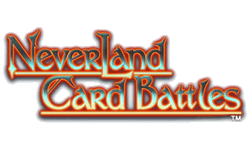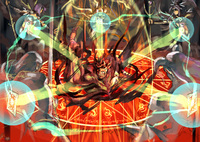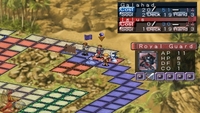|
|

|
PLATFORM
|
PSP
|
BATTLE SYSTEM
|

|
INTERACTION
|

|
ORIGINALITY
|

|
STORY
|

|
MUSIC & SOUND
|

|
VISUALS
|

|
CHALLENGE
|
Hard
|
COMPLETION TIME
|
Less than 20 Hours
|
|
OVERALL

|
+ Amusing character interactions.
+ Solid, challenging battle system.
+ Combines CCG and TRPG mechanics.
- Opponents vastly outclass the player.
- Luck plays a huge factor.
- It's soulless and not very fun.
|
Click here for scoring definitions
|
|
|
Known for creating games which sound fun on paper, then are anything but in execution, infamous developer Idea Factory gifts the world with another attempt at mediocrity with Neverland Card Battles. Originally a 2006 PS2 release in Japan, it was ported to the PSP for Western audiences. The gameplay premise is interesting, combining traditional, tactical RPG elements with a customizable deck of cards from which creatures and spells are drawn. It is a true CCG/TRPG hybrid: the type of game that always made sense, but had yet to be executed. Sadly, it fares similarly to the West's last excursion in Neverland, Spectral Force 3, in that the plot is absent, the visuals are muddy, and the interface is awkward. Although the battle system is solid, it is not particularly enjoyable.
The story does nothing more than justify the unique gameplay. An evil god named Hellgaia is stuck in the basement of a magical shrine. He wants to get out and destroy the world. Stop him. That is the complete plot of the game. As for the details explaining the need for card-based combat, Hellgaia's powers were sealed into hundreds of cards and scattered across the world long ago. Anyone possessing a handful of these cards is teleported to the aforementioned shrine at the start of the game. The hope is that one of these card-fighting Dominators will become powerful enough to reseal the demon-god. Galahad, the
smart-mouthed protagonist, begins at the entrance to the shrine and slowly descends level by level to Hellgaia.
A level starts with Galahad appearing on a new floor, meeting a Dominator there, talking trash until a fight becomes necessary, having a card battle, and then moving to the next floor. The character interactions are entertaining, probably because they pluck the script away from Idea Factory and place it solely in the hands of American writers. Galahad is snarky in a pragmatic, world-weary way rather than the emotional, adolescent way common to JRPGs. Considering that the entire text of the game could not touch the word count of an O. Henry tale, it is packed with laughs without being cheesy or dipping too deeply into the realm of madness. The dialogue is voiced, and voiced well. The actors sound natural and deliver lines in an unforced manner. Galahad in particular has a great voice actor who pulls off the character's persona skillfully. If this is a repeatable example of YUKE'S localization efforts, the company should pick up more JRPGs.
The parts of the presentation handled by Idea Factory, however, are less impressive. While the background music is not bad at all, some of the sound effects are so grating that replacing them with the noise of fingernails on chalkboard would not be much worse. The cards themselves have beautiful, detailed artwork on them. Unfortunately, they are often displayed as small icons, and the compressed graphics are visually unattractive to the point of nearly being indistinguishable from each other. The battlefield view suffers from poor, lazy design with a wide, unzoomable camera angle and no minimap. Units on the field are ugly, crudely drawn sprites that would look more at home in a low quality DS game; jumping from the PlayStation 2 to the PSP did the port's visuals no favors. The interface is missing an easy way to check creatures' skills without pulling up the card graphic that takes a tick to load. For positives, navigating the menus is a snap, and most of the useful information is displayed on the battle screen.
 Gorgeous 2D artwork from Idea Factory? Check.
Gorgeous 2D artwork from Idea Factory? Check.
|
|
Like a customizable card game, battles begin with the two opposing Dominators as the only units on the board. An initial hand is drawn from a player-created deck of thirty cards. All of the tiles on the board are initially gray. Whenever a unit walks across a tile, it becomes part of the Dominator's territory and changes to his color. At the start of each turn, a Dominator gains "cost," the horribly-named resource, equal to the number of tiles in his territory and draws a card. Every card requires cost to use. Galahad can play as many cards as he can afford, including an interesting variety of creature summons, enchantments, instants, and board-altering spells. When a turn is complete, all leftover cost are lost. Playing a creature card summons a minion which then requires cost every turn to keep in play. Also like a CCG, creatures have set skills, stats, and battle abilities, and cannot level up.
The rest of the battle mechanics replicate a typical tactics RPG. The board is a 2D grid, and each creature and Dominator has a set number of squares it can move, after which it may attack an enemy, use a cost-costing skill, or end its turn. A victor is declared when the opposing Dominator is reduced to 0 HP. The one-of-a-kind nature of the game comes from the tactics gameplay's complete reliance on the CCG aspects; without a well-constructed deck and a mind on resource management, victory will be impossible. Galahad's stats are fixed at 25 HP and 3 Attack Points, making him extremely powerful during the beginning stages when enemy Dominators are fairly weak and play with lousy cards. As the game continues, though, Dominators have more life, more AP, and gain powerful skills while Galahad is permanently stuck in his puny state. Exacerbating the balance issue is the opponents' increasingly awesome decks. A few levels into the game, the player will be facing stronger decks controlled by stronger Dominators, and it will take superior deck-building and tactical thought to defeat the souped-up opposition.
 Hideous 2D battlefield from Idea Factory? Check.
Hideous 2D battlefield from Idea Factory? Check.
|
|
The result is a solid battle system that intentionally stacks the deck against the player, requiring a healthy amount of brainpower and luck to overcome the odds. While winning provides that satisfactory feeling of affirming one's mental acuity, it is almost too dry, too cerebral, and too soulless; winning at chess provides the same feeling, but Chessmaster was never a top-selling video game. Due to the CCG components, luck plays a large factor, and it can be infuriating to lose a long, well-played, strategic battle because the computer top-decked the perfect card at the perfect moment. Overall battle length can be a barrier to pleasure, too. Matches are never short, not even overwhelming victories and losses, and CCG match mechanics do not work well with TRPG level lengths. Getting crushed in a game of Magic can take five minutes. Getting crushed in Neverland Card Battles can take thirty.
The worst and most damning sin in the game is the player's handcuffed ability to gain new cards for his deck. In real life, booster packs can be purchased, rare cards can be traded for or bought individually, and one can plan, build and play with any deck imaginable, potentially missing only the most difficult to obtain cards. The starter deck in Neverland Card Battles consists of common, crummy cards. The only way to increase Galahad's supply is by winning randomly selected ones after combat. In addition to the randomness, the broken part here is the horribly low chance of getting anything but more common, weak cards. The player has no way to influence which cards are won, and must craft a coherent deck from a stockpile of underpowered cards -- two things that ruin the CCG, deck-building part of the game. The goal by the end of the game, then, is to take advantage of the mindless AI and the inherent weaknesses in decks consisting of nothing but rare, high-cost cards to somehow defeat a Dominator with significantly higher stats than Galahad. In theory, one could replay old levels ad nauseum in the empty hope of luckily earning a decent card, but even fast maps take a long time to finish, and the rewards are often disappointing. Neverland Card Battles is indeed unique and the first game to accurately combine a CCG with a TRPG; however, although it is not bad, the execution has just enough holes in it to keep the game from being fun.
Review Archives
|









